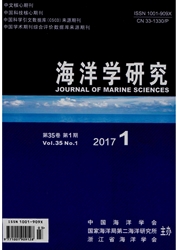

 中文摘要:
中文摘要:
在深海的沉积的热水的材料在海中央山脉提供柔韧的 tracer 给局部性的热水的活动。为从散布西南印度理兹的 ultraslow 收集的表面沉积的专业,踪迹和稀土元素元素(REE ) 数据被介绍检验热水的部件的存在。源於生物的碳酸盐淤泥统治所有沉积样品,与在一个不稳定免费的基础上从 85.5% ~ 89.9% 变化的 CaO 内容。由~的体积沉积的沥滤的残余5% HCl 在 SiO 2,艾尔 2 O 3, CaO , MgO ,碱元素( Rb , C )并且高地力量元素( Nb , Ta , Zr , Hf , Ti )。这些招待岩屑的元素被推断显著地借助于 eolian 灰尘从澳大利亚的大陆被发源,当本地 volcaniclastics 的贡献是不足道的时。另外,剩余部分与 UCC 相比在 Fe, Mn,和 Ba 显示出清楚的丰富。联合反对 UCC 的剩余部分的积极 Eu 异例但是热水的液体特征、联系猛抛发生在海中央山脉,局部性的热水的部件的加入能被抑制。多于在剩余部分(~55%60%) 以内的半 REE 从一个热水的部件被导出, REE 混合计算显示那,它被推断从一个弥漫的液体矿化作用被结果。低温度的弥漫的流动可以广泛地沿着散布外壳的差错和裂缝丰富的山脉的 slow-ultraslow 被散布,并且可能有一个大矿化作用潜力。
 英文摘要:
英文摘要:
Hydrothermal materials in deep-sea sediments provide a robust tracer to the localized hydrothermal activity at mid-ocean ridges. Major, trace and rare earth element(REE) data for surface sediments collected from the ultraslow spreading Southwest Indian Ridge are presented to examine the existence of hydrothermal component.Biogenic carbonate oozes dominate all the sediment samples, with CaO content varying from 85.5% to 89.9% on a volatile-free basis. The leaching residue of bulk sediments by ~5% HCl is compositionally comparable to the Upper Continental Crust(UCC) in SiO_2, Al_2O_3, CaO, MgO, alkali elements(Rb, Cs) and high field strength elements(Nb, Ta, Zr, Hf, Ti). These detritus-hosted elements are inferred to be prominently derived from the Australian continent by means of eolian dust, while the contribution of local volcaniclastics is insignificant. In addition, the residual fraction shows a clear enrichment in Fe, Mn, and Ba compared with the UCC. Combining the positive Eu anomaly of residual fraction which is opposed to the UCC but the characteristic of hydrothermal fluids and associated precipitates occurred at mid-ocean ridges, the incorporation of localized hydrothermal component can be constrained. REE mixing calculations indicate that more than half REE within the residual fraction(~55%–60%) are derived from a hydrothermal component, which is inferred to be resulted from a diffuse fluid mineralization. The low-temperature diffuse flow may be widely distributed along the slow-ultraslow spreading ridges where crustal faults and fissures abound, and probably have a great mineralization potential.
 同期刊论文项目
同期刊论文项目
 同项目期刊论文
同项目期刊论文
 期刊信息
期刊信息
